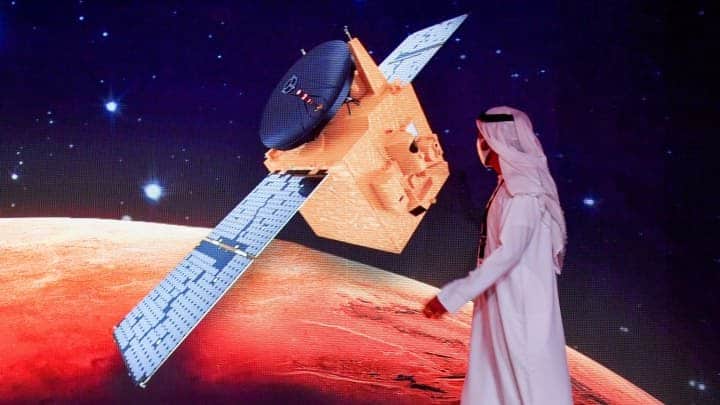-
Courtesy images, detailed and clear observations have been made globally for the first time
-
Observations go above and beyond the original science goals of the Emirates Mars Mission
Emirates Mars Mission, the first interplanetary exploration undertaken by an Arab nation, released the first global images of Mars in the far-ultraviolet, providing new insights into the discrete aurora phenomenon in Mars’ nightside atmosphere.
A statement issued by Emirates Mars Mission said the images have revolutionary implications for our understanding of the interactions between solar radiation, Mars’ magnetic fields and the planetary atmosphere.
Hessa Al Matroushi, Emirates Mars Mission Science Lead, said the images are the first time such detailed and clear observations have been made globally, as well as across previously unobservable wavelengths.
“The implications for our understanding of Mars’ atmospheric and magnetospheric science are tremendous and provide new support to the theory that solar storms are not necessary to drive Mars’ aurora,” said
The images, taken by the Hope Probe’s EMUS (Emirates Mars Ultraviolet Spectrometer) instrument, show a ghostly glow known as the discrete aurora.
Its intricate patterns trace out the regions where Mars’ enigmatic crustal magnetic fields act like a funnel to guide fast electrons from space down into the atmosphere, causing it to shimmer like Earth’s aurora.
This influence of localised magnetic fields is a unique feature of the Red Planet as Mars, unlike Earth, does not have a global magnetic field generated by the planet’s core.
The most sensitive ultraviolet instrument yet to orbit Mars, EMUS can image these dynamic auroral events globally at high resolution and across a wide range of wavelengths, providing an unprecedented window upon the interaction of the atmosphere with solar particles, the statement said.
While previous studies had theorised the discrete aurora is tied to Mars’ magnetic fields and existing observations had been consistent with that theory, prior images of this phenomenon at this quality had only been available as artist’s impressions.
“We have totally blown out ten years of study of Mars’ auroras with ten minutes of observations,” said EMM Deputy Science Lead Justin Deighan.
“The data we are capturing confirms the tremendous potential we now have of exploring Mars’ aurora and the interactions between Mars’ magnetic fields, atmosphere and solar particles with a coverage and sensitivity we could only previously dream of. These exciting observations go above and beyond the original science goals of the Emirates Mars Mission,” he said.
The Hope Probe reached Mars orbit in 2021, the 50th anniversary of the foundation of the UAE, which became an independent nation on December 2, 1971.
Hope is a fully autonomous spacecraft, carrying three instruments to measure Mars’ atmosphere. Weighing some 1,350 kg, and approximately the size of a small SUV, the spacecraft was designed and developed by MBRSC engineers working with academic partners, including LASP at the University of Colorado, Boulder; Arizona State University and the University of California, Berkeley.
The Emirates Mars Mission will study the Martian atmosphere, the relationship between the upper layer and lower regions and, for the first time, the international science community will have full access to a holistic view of the Martian atmosphere at different times of the day, through different seasons.








